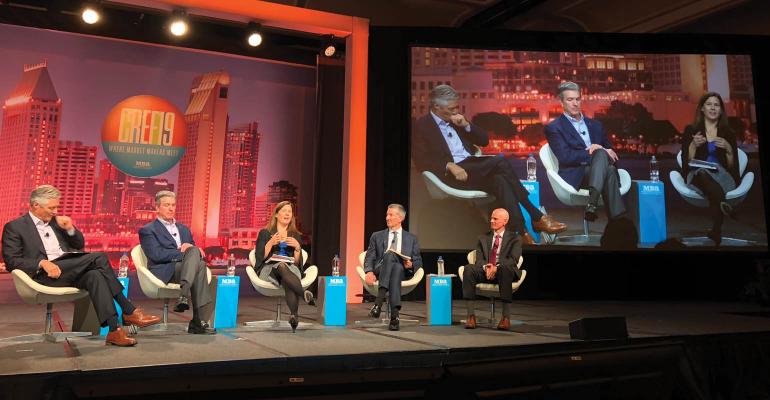As the MBA CREF/Multifamily Housing Convention & Expo 2019 continued on Tuesday, panelists provided an outlook for the investment sales market, discussed the issues surrounding Opportunity Zones investment and reviewed the commercial real estate industry’s progress in tackling its diversity problem. Here are some takeaways from Tuesday’s sessions.
- Activity in the investment sales sector will likely continue to be strong this year, according to participants in “Investment Sales Trends in a CRE Finance Landscape” panel, though property prices may have reached their ceiling for this cycle, according to Bret Morriss, managing director with Stream Realty Partners. “I think the big concern is that rent growth will not keep up with cap rate expansion,” Morriss noted. “At some point, it will have to catch up. As cap rates widen, rent growth has to go up”—otherwise, the deals may end up not working.
- Alternative property types continue to gain popularity with investors, according to Blake Okland, head of multifamily investment sales with Newmark Knight Frank. “I am stunned” by the amount of foreign investors who are “more interested in seniors and student housing than they are in core product types,” Okland noted.
- Echoing comments made a day earlier by Hana’s Scott Marshall, Morriss warned office building owners that they may want to limit the percentage of their space leased to co-working operators. “From a leasing perspective, it’s a really good alternative for a tenant,” he said. “On the flip side, for a landlord, you really need to be careful. If you are giving more than 12 to 15 percent of your space to WeWork, you need to look at how that’s going to affect your debt service coverage ratio.” Jeffrey M. Bramson, senior managing director and managing broker with HFF, expressed a similar sentiment. “I’ve seen some cycles, I’ve lived through the dot.com boom, I’ve seen all the fads come and go,” he said. “The pendulum always swings back. Not everybody wants to seat on a bench, or have to leave the desk for a phone call.”
- Co-living, on the other hand, may be a trend that has some serious staying power as the country continues to battle an affordable housing shortage, according to Okland. In fact, in cities with extremely high rents, including New York and San Francisco, municipal governments may insist on lease provision that give the tenants the ability to “co-live or re-let,” he noted.
- Millennials’ demand for more flexible living spaces and new amenities has also created the opportunity for more value-add plays, Okland said. At the current point in the cycle “you can say ‘who buys a value-add deal that’s been value-added?’ Well, another value-add buyer because it’s been three years.”
- The Opportunity Zone program has the potential to become very “binary,” either helping revive under-served communities or resulting in high-profile scandals, noted Shekar Narasimhan, managing partner with Beekman Advisors, during a panel discussing “Opportunity Zones and CRE.” “It will be a big disappointment to me if most of [the investment from] this tax break that will benefit ultra wealthy people will go to 3 percent of these zones on deals that would have been done anyway,” Narasimhan noted, citing that some of the designated Opportunity Zones are located in areas such as Queens, N.Y., Somerville, Mass. and Berkeley, Calif.
- The program’s rules also make it likely that most of the real estate investment will take the form of new construction, since it would be difficult to make the numbers pencil out on deals involving an existing asset, Narasimhan said. He expects that 50 to 60 percent of that investment will take the form of multifamily and single-family rental projects, a significant percentage will be devoted to last-mile industrial facilities and some of the money will go toward hotel construction.
- During an earlier panel on “Transitional Lending in a Transitional Economy,” Matt Salem, head of real estate credit with KKR, noted that his team would not feel comfortable providing bridge loans on properties in areas that can’t show existing growth, even if there were tax benefits to doing the deal. “The idea that there’s not growth, and you need a government program to spur it, that’s not something we are going to wait for,” he said. Bridge lenders need to see that there will be enough demand for the project to support the first refinance, according to John Lippmann, senior director with New York Life Real Estate Investors. Otherwise, the risk might be seen as too great to take on.
- The commercial real estate finance industry continues to have trouble creating a diverse workforce. When credit ratings agency DBRS visits college campuses to recruit new employees, only about one in eight job applications comes from a woman, according to Erin Stafford, managing director with the firm. “That’s where we are seeing the breakdown,” Stafford said during a panel on “Leadership in This Competitive Age.” “We’re just not getting them into the workforce.”
On the other hand, Stafford offered some reassurance that the industry is still looking strong when it comes to property fundamentals, with no expectation of a downturn this year. While there has been some slowing in NOI growth in 2018, “from the first mortgage perspective, those look very healthy,” she said. “In terms of fundamentals, it feels much better” than it did in 2006-2007.





